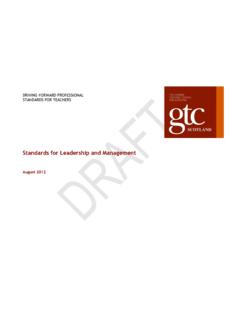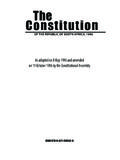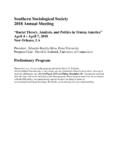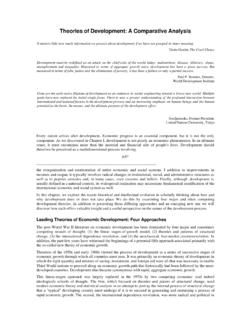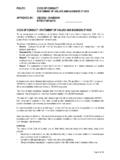Transcription of Women and Development
1 UNESCO EOLSSSAMPLE CHAPTERSINSTITUTIONAL ISSUES INVOLVING ETHICS AND justice - Women and Development - Hurriyet Babacan Encyclopedia of Life Support Systems (EOLSS) Women AND Development Hurriyet Babacan University of the Sunshine Coast, Australia Keywords: Gender, Women , Development , inequality, empowerment Contents 1. Introduction 2. Critique of the Discourse of Development 3. Development and Women 4. Integrating Women into Development 5. Women in Development : Issues and Problems 6. Women , Globalization, and Development 7. Visions for Change: Ways Forward Bibliography Biographical Sketch Summary This article focuses on how gender, as a socially constructed phenomenon, has been integrated into Development practice.
2 It examines the notion of Development as generated by an economic paradigm that renders the work of Women invisible. Further, it critiques the different ways in which Women have been incorporated into Development policies and program. An examination of issues facing Women in the Development process is undertaken. The article explores the processes of globalization that are operating at unprecedented levels and how they affect Women in Development . It raises the question of a crisis in Development as a Western colonial project, and analyzes this from the perspective of social justice .
3 It concludes with alternative visions for Women in Development in the future. 1. Introduction Women constitute half of the world s population. In 1948, the Universal Declaration of Human Rights reaffirmed the equal rights of men and Women . Despite this, Women experience considerable disadvantage and discrimination in societies perpetuating gender-differentiated structures. Gender is a socially constructed phenomenon, while sex is biologically determined. The meaning of gender varies from society to society and changes over time. Women are not a homogeneous group and their lives vary depending on the place in which they live as well as their age, social class, ethnic origin, and religion.
4 For all societies, the common denominator of gender is female subordination, although relations of power between men and Women may be experienced and expressed in different societies and at different times. The United Nations ( ) Development Programme (UNDP) unequivocally concluded that no society treats its Women as well its men. In 1985 it was reported to the Committee on the Status of Women that UNESCO EOLSSSAMPLE CHAPTERSINSTITUTIONAL ISSUES INVOLVING ETHICS AND justice - Women and Development - Hurriyet Babacan Encyclopedia of Life Support Systems (EOLSS) Women composed one-half of the world s population and performed two-thirds of the world s work hours, earned one-tenth of the world s income, owned less than one-hundredth of the world s property, and were everywhere poorer in resources and poorly represented in positions of power.
5 Little has changed. The Human Development Index (HDI), constructed to measure achievements in basic human Development across the world, measures gender inequality in terms of economic and political opportunity and gender empowerment in terms of participation and decision making. The 2001 HDI indicated that gender inequality was present in every country, although there were considerable variations across nations. International Development as an area of scholarly study can be traced back to the 1950s and post-World War II reconstruction. Based on neoclassical economic theory there emerged a Development project that stressed aid-based planning to bridge the gap between industrialized and non-industrialized nations.
6 The first Development decade took place from 1961 to 1970. It is in this decade that the terms less developed countries, third world, and developing countries were created. These terms are problematic, as will be seen below. Women s issues in Development were subsumed under the question of human rights in the 1950s and 1960s. By the 1970s Women s key position in the Development process was more widely recognized. This was particularly so in relation to population growth and food security issues. Women s roles in society were viewed as important to consider in the Development process, as policies and programs implemented often had adverse effects on Women .
7 Development strategies came under criticism from Women practitioners for their failure to recognize the contribution Women make to the economy in many developing countries while lacking political and social power. It was pointed out that, in all societies, men and Women have different responsibilities for the tasks necessary for the survival and Development of the community. However, within the existing division of labor, responsibility for the maintenance of human resources fell largely on Women s shoulders. Gathering fuel and water, processing food, caring for the children, nursing the sick, and managing the household is heavy and time-consuming work.
8 This is widely seen as a woman s role, and is economically not recognized. The recognition of this has led to the inclusion of gender in the Development process as a key indicator, and the emergence of a series of terms as Women in Development , gender and Development , and Women s Development . 2. Critique of the Discourse of Development The discussion of Women in Development requires a review of the discourse on Development . A variety of approaches to Development have emerged over the several decades of Development practice. A growing body of critical literature has looked at the ideology and paradigm of Development .
9 The term Development evokes a positive image, as something that is desirable. Often Development has not been connected to the processes of capitalism despite the fact that it is intricately related to economics. Through the criticisms that are voiced from grassroots movements in the developing world against, for example, the construction of big dams, the destruction of rainforests, and the destruction of traditional forms of livelihood and agriculture in the name of UNESCO EOLSSSAMPLE CHAPTERSINSTITUTIONAL ISSUES INVOLVING ETHICS AND justice - Women and Development - Hurriyet Babacan Encyclopedia of Life Support Systems (EOLSS) Development , we have come to realize the connections between capitalism and Development .
10 The main theme of Development discourse focuses on the causes of deprivation and strategies to alleviate it. The orthodox paradigm of Development sees deprivation as resulting from deficiencies in economic functioning and advocates economic growth as a way to overcome poverty, unemployment, and lack of income. This school of thought sees economic growth as the first step towards a trickling down and does not see the deprivation as resulting from unequal power between classes, regions, nations, or gender. This school advocates minimal intervention so that the economic system can function effectively with minimal interference.










